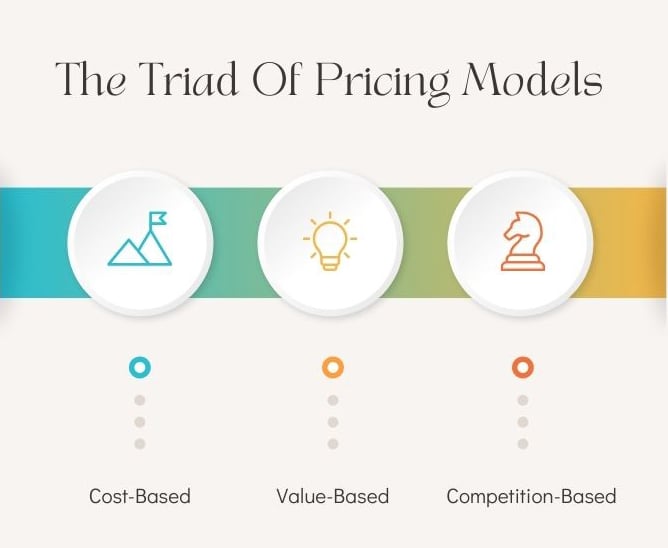Is Backlinking from Blog Comments a Good or Bad SEO Tactic?
In the ongoing fight to get your website ranked highly by Google, many folks look to backlinking as one of the best options to achieve this result....
9 min read
 Bill Walls
:
Nov 28, 2023 1:48:54 PM
Bill Walls
:
Nov 28, 2023 1:48:54 PM

In the dynamic business landscape, pricing stands out as a pivotal element. Beyond merely impacting profitability, it influences customer perceptions and overall market positioning. Navigating this terrain successfully requires a meticulous approach to setting pricing objectives. This article delves into the intricacies of various pricing methods, provides examples of pricing objectives, and offers strategies to optimize the pricing of products for both profitability and customer satisfaction.
Defining your pricing strategy is important before delving into the world of pricing objectives. This strategic choice should harmonize with your business goals, target market, competitive environment, and the value you deliver to customers. Are you leaning towards premium pricing, positioning your products as high-quality and exclusive? Or perhaps, you're embracing a penetration pricing strategy, aiming to capture a larger market share through competitive pricing? Aligning your pricing strategy with your business context serves as a compass for setting effective pricing objectives.
In pricing, three major methods take center stage:cost-based pricing, value-based pricing, and competition-based pricing.

Consider the pricing objective of maximizing profit. This objective entails setting prices that yield the highest possible profit margin. Achieving this goal demands a nuanced evaluation of costs, demand, and competition while ensuring the attractiveness of prices to customers.
To optimize the profitability of your products or services, consider these strategies:
One of the most pervasive and widely recognized psychological pricing strategies is charm pricing. Instead of rounding up to the nearest dollar, prices are deliberately set just below, often ending with the digit 9. For instance, pricing an item at $9.99 instead of $10 creates a perceptual shift. The consumer's mind tends to focus on the first digit, perceiving the price as closer to $9 than $10. This subtle manipulation fosters the illusion of a more economical purchase, even when the difference is marginal. Charm pricing is a tactic deeply ingrained in consumer psychology, leveraging the allure of a bargain and tapping into the impulse to perceive the lower figure. Consider also the value of 7. At $9.99 or $9.97, which is a perceived better value?
Anchoring is a strategic maneuver that involves presenting a higher-priced option as the initial reference point. By introducing a premium or deluxe version of a product before showcasing other alternatives, subsequent options appear more reasonable in comparison. This psychological pricing strategy capitalizes on the anchoring effect, where the initial price presented becomes a mental reference point for evaluating subsequent choices. Consumers, anchored by the first price they encounter, are more inclined to view subsequent, lower-priced options as attractive deals. Anchoring subtly guides consumer perceptions, steering them towards choices that align with the reference point established.
Premium pricing is a strategic move to position products as high-quality and exclusive, justifying a higher price point in the minds of consumers. This approach relies on associating the product with superior attributes such as craftsmanship, innovation, or exclusivity. By framing the narrative around these qualities, consumers are led to believe that the elevated price tag corresponds to a commensurate increase in value. Premium pricing is not merely about charging more; it is a meticulous cultivation of brand image, fostering a perception of uniqueness and distinction. In turn, consumers may derive prestige and satisfaction from choosing a product associated with premium qualities.
Expanding on the psychology of pricing involves considering tiered pricing models. Businesses tap into the psychological principle of perceived value by presenting consumers with multiple options at different prices. The tiered structure creates a spectrum of choices, allowing consumers to select products that align with their preferences and budget. The presence of different tiers fosters the perception that each option represents a unique value proposition. This accommodates a diverse range of consumers and influences perceptions of the brand's flexibility and commitment to providing tailored solutions.
The psychology of pricing extends beyond the actual figures; it encompasses the dynamics of time and scarcity. Limited-time offers, flash sales, and scarcity-based promotions create a sense of urgency and exclusivity. Businesses tap into consumers' fear of missing out by emphasizing the fleeting nature of a deal or the limited availability of a product (FOMO). The time-sensitive nature of such promotions leverages psychological triggers, compelling consumers to make quicker decisions and, in many cases, pay a premium for the perceived exclusivity.
The way discounts are presented can significantly impact consumer perception. While a flat discount amount might be straightforward, percentage-based discounts can create different perceptions. For instance, a product marked as "Save 20%" may convey a more substantial savings impression than an equivalent flat dollar amount. This framing subtly influences the perceived value and attractiveness of the discount, playing into the psychology of perceived savings.
You need to be careful with discounting, offer it too much, and you’ll train your customers to wait until the next discount arrives before making a purchase.
In essence, the psychology of pricing is a multifaceted realm where subtle nuances can profoundly influence consumer behavior. Charm pricing, anchoring, premium pricing, tiered models, limited-time offers, scarcity, and discount framing are not isolated strategies but components of a strategic orchestration designed to shape perceptions, trigger emotions, and guide consumers toward decisions that align with the seller's objectives. Understanding these psychological dynamics empowers businesses to set prices and craft an immersive and persuasive narrative that resonates with the intricate workings of the consumer mind.
Before embarking on the online selling journey, thoroughly analyze the pricing landscape for similar products. This involves not only understanding the pricing strategies of direct competitors but also grasping the broader market trends. Identify the sweet spot where your prices are competitive yet allow for a profitable margin. Look into customer reviews, industry reports, and online platforms to understand what pricing points resonate with your target audience. Recognize that online markets can be dynamic, and staying informed about pricing fluctuations is key to maintaining a competitive edge.
The online shopping experience extends beyond the virtual cart, and savvy sellers factor in shipping costs when determining product prices. Shipping costs can substantially impact overall profitability, and pricing transparency builds customer trust. Explore various shipping options, negotiate with carriers, and consider incorporating shipping costs into the product price or offering transparent shipping fee structures. Additionally, leverage promotional strategies such as free shipping thresholds to incentivize higher order values. This holistic approach ensures that your online prices reflect not just the product but the end-to-end customer experience.
The online marketplace is dynamic, and the effectiveness of your pricing strategy may evolve over time. Continuously monitor customer responses, sales volumes, and market trends to gauge the impact of your pricing decisions. Implement analytics tools and customer feedback mechanisms to understand how your audience perceives your prices. Be agile in your approach, ready to adjust prices based on real-time data. Experiment with limited-time promotions, bundle offers, or loyalty programs to observe their impact on sales and customer loyalty. The ability to adapt and fine-tune your pricing strategy in response to market dynamics is a hallmark of successful online selling.
Consider adopting dynamic pricing strategies that respond to real-time market changes, demand fluctuations, and competitive moves. Dynamic pricing involves adjusting prices based on factors such as inventory levels, customer behavior, and external market conditions. Use algorithms and data analytics to automate this process, ensuring that your prices remain competitive and reflective of market conditions. Dynamic pricing optimizes profitability and positions your products strategically in the ever-changing online landscape.
In the competitive realm of online selling, prices are just one component of the value equation. Highlight the unique value proposition of your products or services. Emphasize factors such as product quality, customer service, and hassle-free returns. Communicate these value-adds through your online channels to justify your pricing and differentiate your offerings from competitors. A compelling value proposition enhances customer loyalty and can justify slightly higher price points, contributing to sustained profitability.
Utilize customer data intelligently to refine your pricing strategy. Analyze purchase histories, browsing patterns, and feedback to understand customer preferences. Implement personalized pricing strategies or targeted promotions based on individual customer behavior. This enhances customer satisfaction and contributes to a more precise and effective pricing strategy tailored to your audience.
Incorporate educational content about your pricing strategy on your online platforms. Transparently communicate the factors influencing your pricing decisions, such as quality standards, ethical sourcing, or sustainable practices. Educate customers on the value they receive by choosing your products. This transparency fosters trust and helps justify your pricing structure, creating a more informed and supportive customer base.
By conducting comprehensive market research, strategically considering shipping costs, agile testing and adjustment, adopting dynamic pricing strategies, emphasizing your value proposition, leveraging customer data, and incorporating educational content, you can create a pricing strategy that not only optimizes profitability but also establishes a strong and lasting presence in the competitive online marketplace.
Choosing the right pricing strategy for a small business is a critical decision that demands a thoughtful approach, considering the inherent challenges and nuances unique to smaller enterprises. Here are several key factors that should shape your pricing strategy:
A deep understanding of your costs lies at the core of any effective pricing strategy. For small businesses, where every expense can significantly impact the bottom line, it's imperative to define your cost structure meticulously. Consider not just the direct costs of production but also the indirect costs like overheads, marketing, and distribution. Ensure your prices cover all expenses while leaving room for a sustainable profit margin. This holistic understanding of costs forms the bedrock for a pricing strategy that ensures financial viability and long-term sustainability.
Small businesses operate in dynamic markets where competitors abound. Conduct thorough market research to grasp the pricing strategies employed by competitors. Analyze the pricing landscape for similar products or services to identify trends and benchmarks. Evaluate customer demand, considering purchasing power, preferences, and trends. This research provides a contextual understanding of the market and reveals opportunities for differentiation. By aligning your pricing strategy with market realities, you can position your small business strategically, balancing competitiveness with profitability.
In a crowded marketplace, your small business's unique value can be a game-changer. Understand the distinctive qualities of your products or services that set them apart from competitors. This could be exceptional quality, personalized service, innovative features, or a combination of factors. Price your offerings to reflect this unique value proposition. Consumers are often willing to pay a premium when they perceive added value. Communicate these differentiators clearly through your marketing channels, ensuring that your pricing aligns with the value customers receive.
Building on your value proposition, consider how your pricing strategy contributes to the differentiation and positioning of your small business. Are you positioning yourself as a budget-friendly option, offering affordability to a broader audience? Or do you aim to be a premium choice, emphasizing exclusivity and superior quality? The chosen positioning influences not only your pricing structure but also your overall branding and marketing strategies. Small businesses can often excel by carving a niche based on a unique combination of factors, and your pricing should complement this strategic positioning.
Small businesses often operate in agile environments where adaptability is a key asset. Consider implementing flexible pricing models that allow you to respond swiftly to market changes, demand fluctuations, or competitive shifts. This adaptability could involve seasonal promotions, bundling options, loyalty programs, or limited-time discounts. By staying nimble in your pricing approach, you can seize opportunities and mitigate challenges, enhancing the resilience of your small business in a dynamic market.
Customer feedback is a valuable source of insights for refining your pricing strategy. Actively seek input from your customer base on their perceptions of value, pricing sensitivity, and expectations. Use this feedback to adjust your pricing models based on real-world responses. A continuous feedback loop ensures that your pricing strategy evolves in alignment with customer needs and market dynamics, fostering a customer-centric approach.
Small businesses often grapple with the decision between cost-plus and value-based pricing models. While understanding your costs is foundational, value-based pricing allows you to capture the perceived value your offerings provide customers. Striking the right balance between these approaches is crucial. Consider how your unique value proposition aligns with customer expectations and market benchmarks, and let this guide your decision on whether to anchor pricing primarily on costs or perceived value.
By understanding your costs, conducting thorough market research, embracing your value proposition, differentiating strategically, adopting flexible pricing models, incorporating customer feedback, and finding the right balance between cost and value-based pricing, your small business can establish a resilient and effective pricing strategy that propels growth in a competitive landscape.
The art of setting pricing objectives is pivotal in finding the sweet spot that maximizes both profitability and customer satisfaction. By comprehending diverse pricing methods, implementing effective strategies, and considering psychological aspects, you can successfully price your products or services to achieve optimal profitability. Never overlook the importance of thorough market research, cost analysis, and a compelling value proposition when choosing a pricing strategy for your small business.

In the ongoing fight to get your website ranked highly by Google, many folks look to backlinking as one of the best options to achieve this result....

As a marketing agency that focuses on helping businesses grow, the most common request we get is to help businesses with their lead generation.

Getting new customers is one of the biggest challenges that businesses face on a daily basis.